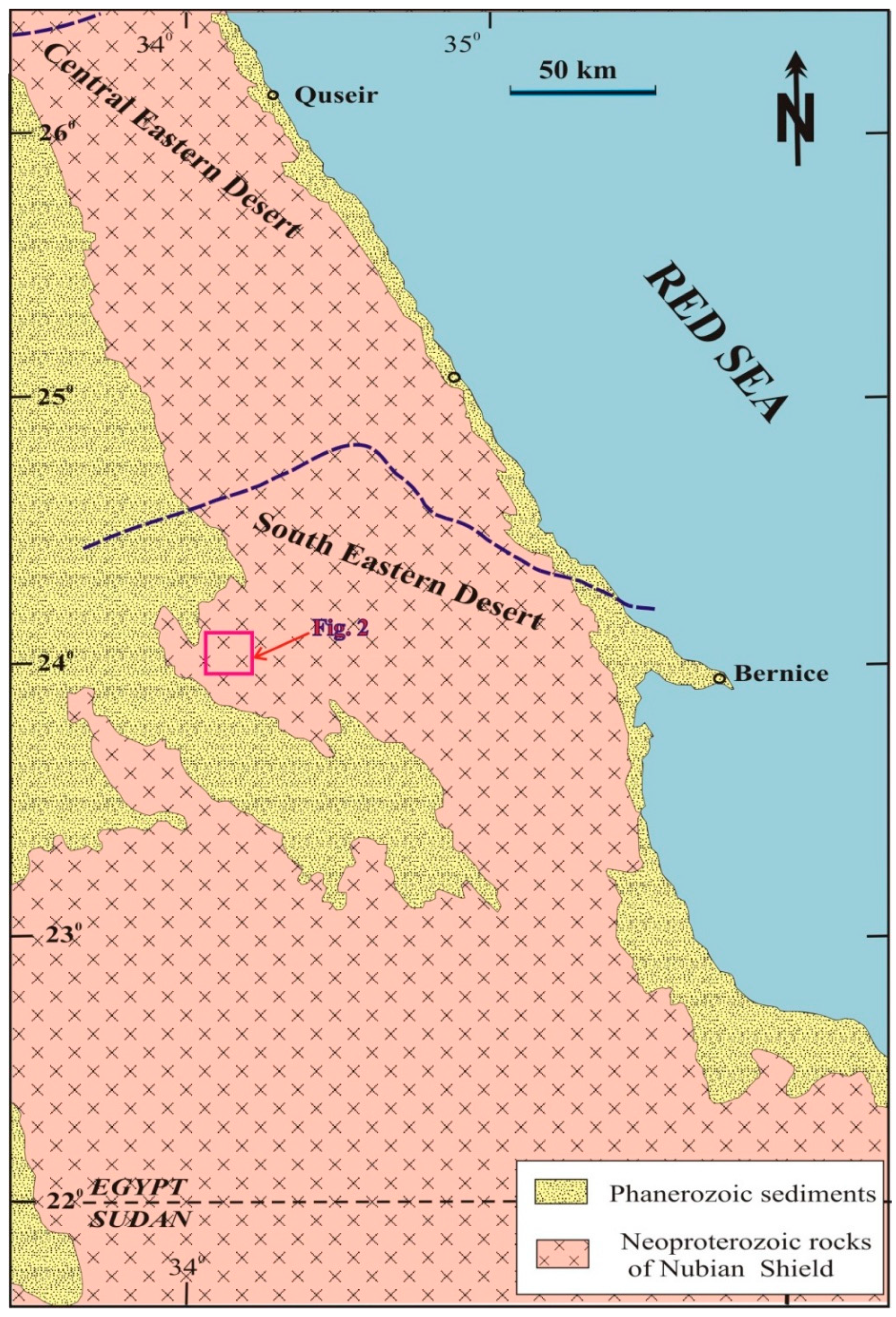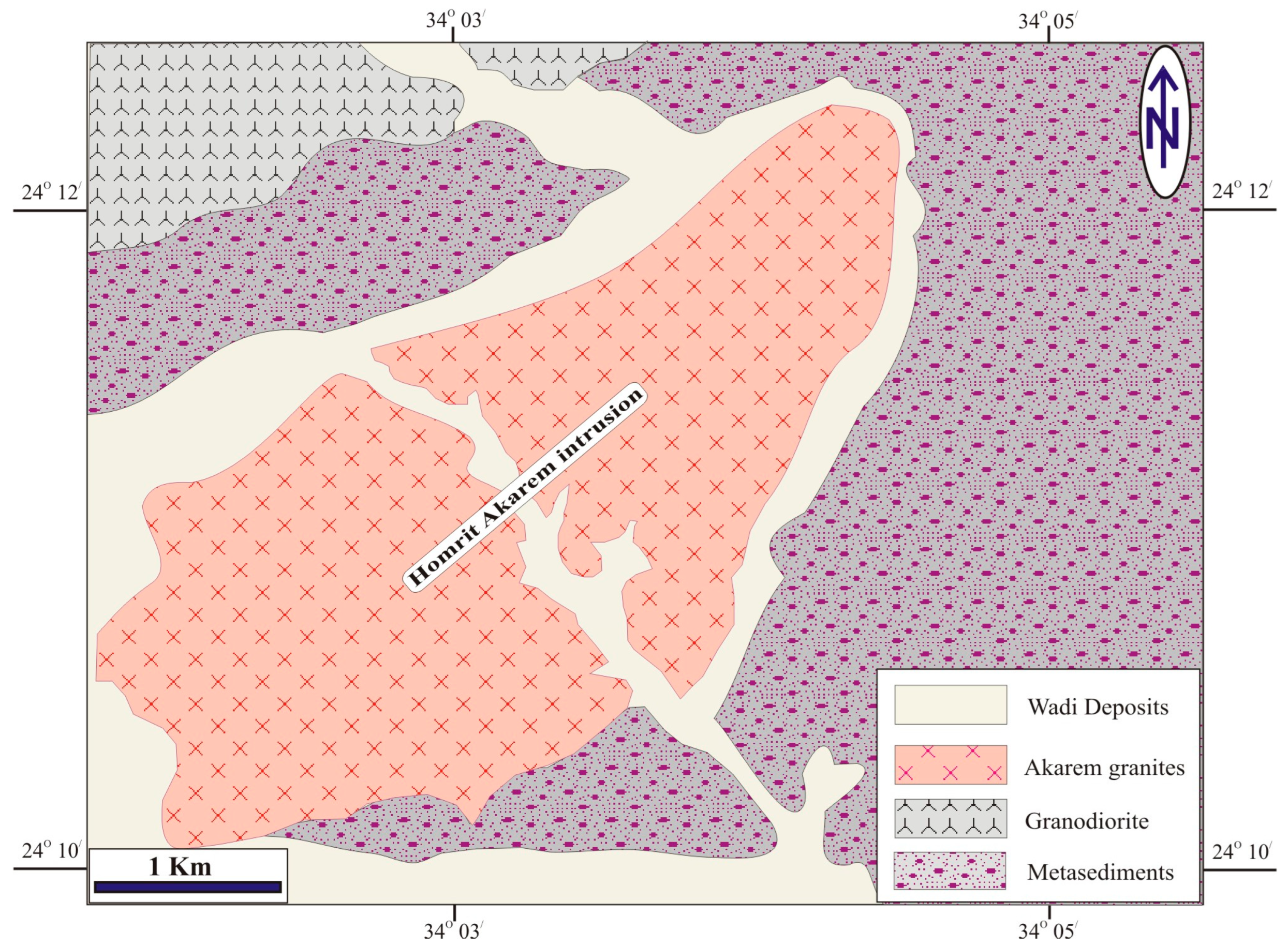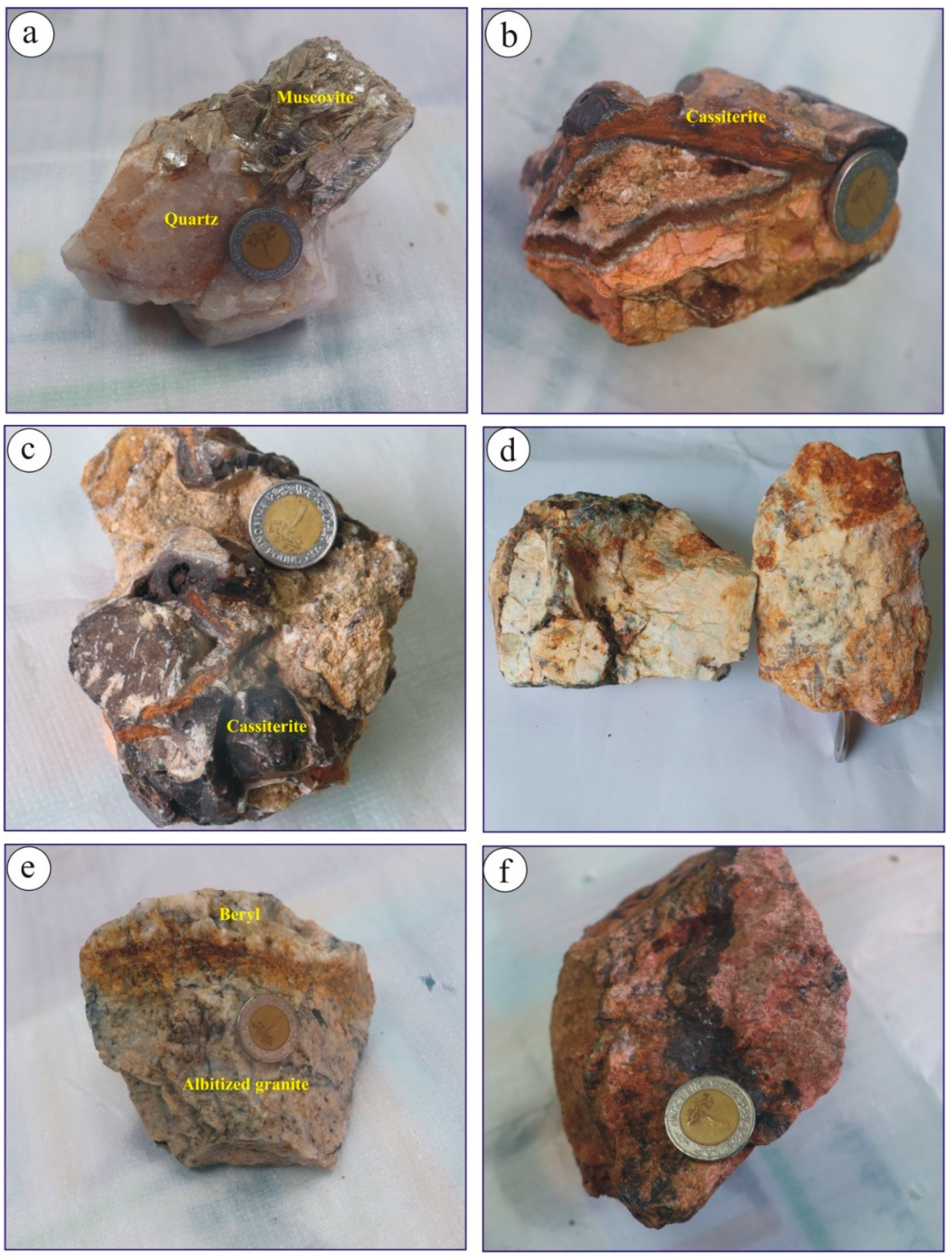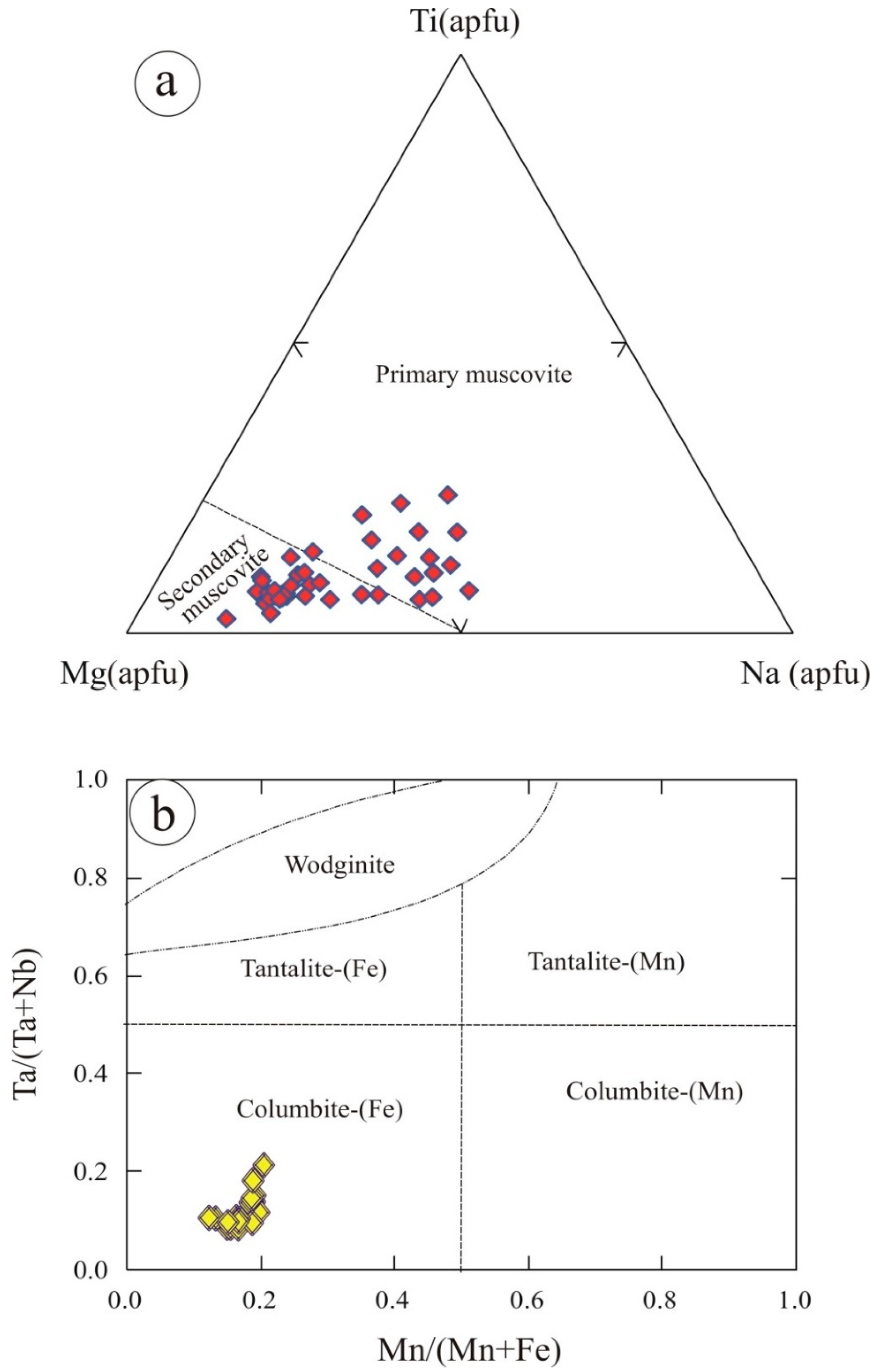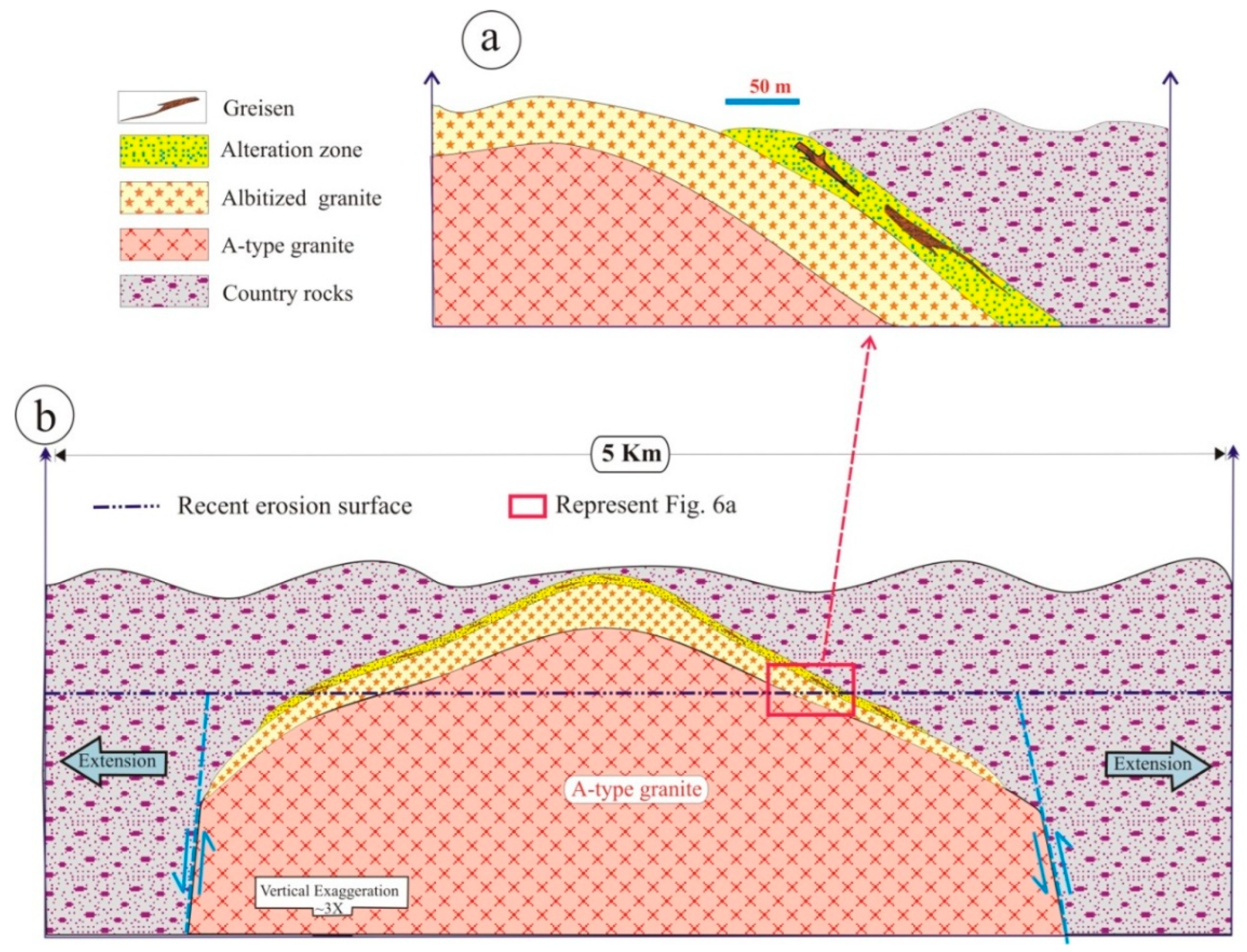1. Introduction
Greisens are metasomatic rocks that form through the hydrothermal alteration of granites and/or their country rocks during the late stage of granitic magma crystallization [
1,
2,
3,
4,
5]. They are considered key to mineralization because the last hydrothermal fluids associated with granitic intrusions tend to concentrate incompatible metals, such as tin, beryllium, tungsten, molybdenum, niobium, and tantalum [
6,
7].
The Egyptian Nubian Shield contains voluminous granitoids of varying ages, geochemical characteristics, origins, and geotectonic settings (e.g., [
8,
9,
10,
11]). The authors of [
11] classified the Egyptian granitoids into a three-fold petrological classification scheme, which includes synorogenic calc-alkaline granitoids, late-to post-orogenic calc-alkaline granitoids, and post-orogenic alkaline granites. Some post-collisional granitic intrusions are often modified by metasomatic processes, including albitization, silicification, and greisenization, which lead to their enrichment in certain rare metals of substantial economic significance, such as REE, Nb, Ta, Zr, U, and Th (e.g., [
11,
12,
13]).
Greisens have been documented in various locations within the Eastern Desert of Egypt, including Homrit Akarem, Abu Dabbab, Nuweibi, Um Naggat, Mueilha, Homrit Waggat, Igla, and Abu Rusheid (e.g., [
5,
14,
15]). The present study deals with the greisens associated with the post-collisional granites of Egypt; these greisens have not been thoroughly investigated to understand their formation from a petrological perspective. In the present work, we present new field data, a petrographic investigation, and the mineral chemistry of the greisens related to the Homrit Akarem intrusion. In addition, our aim is to discuss the greisenization that occurred during the hydrothermal processes and the mineralization in the cupola structure associated with post-collisional granites in the Egyptian Nubian Shield.
2. Geologic Setting
The study area is located at the western edge of the Egyptian Nubian Shield outcrop in the Southeastern Desert of Egypt (
Figure 1), between latitudes 24°9′ and 24°13′ N and longitudes 34°1′00″ and 34°5′40″ E. It is primarily composed of metamorphosed island-arc rocks and intrusive granitoids (
Figure 2). The island-arc rocks represent the oldest rock units in the mapped area and are highly deformed and metamorphosed. They include metasedimentary rocks with minor metavolcanics varieties. The intrusive granitoids are represented by granodiorite and post-collisional granites. The granodiorite contains various xenoliths of the metamorphosed island-arc rocks.
The post-collisional granites of the Homrit Akarem intrusion intrude into metamorphosed volcano-sedimentary successions, exhibiting sharp intrusive contacts. The core of the Homrit Akarem intrusion consists of alkali feldspar granite, which grades into muscovite granite and albitized granite. Alkali feldspar granite is the predominant rock type, while muscovite granite is less common and serves as the transitional zone between the pink granite and the whitish albitized granite that constitutes the marginal and the apical parts of the Homrit Akarem intrusion. The outer margins of the albitized granite are subjected to intense silicification and greisenization processes, and they are also penetrated by numerous pegmatite and fluorite veins.
In the study area, greisens are irregularly distributed along the margins of the albitized granite. They appear as pockets or as veins filling fractures and can also form extensive selvages surrounding quartz veins, occasionally extending into the surrounding country rocks. Greisens are easily identifiable in the field due to their bleached colors, and they are sometimes fragmented. The recorded greisen bodies associated with the Homrit Akarem intrusion can be classified into four types: muscovite-rich (
Figure 3a), cassiterite-rich (
Figure 3b,c), topaz-rich (
Figure 3d), and beryl-rich (
Figure 3e) greisens. The muscovite-rich greisen is prevalent as veins (~100 m long), cutting through the albitized granite and extending into the country rocks. Cassiterite-rich greisen occurs as clusters of subparallel veins that range from 10 to 40 cm in thickness and from 100 to 400 m in length. Topaz-rich and beryl-rich greisens are found as selvages around quartz veins in the country rocks adjacent to the granitic intrusion. Locally, greisens may be stained red or black due to impregnation with Fe or Mn oxides (
Figure 3f) during the late stages of hydrothermal alteration. Several fluorite veins and pods have been observed cutting through the greisen bodies, confined to the same fracture trends that control the endogreisen bodies.
4. Petrography
The petrographic study of the Homrit Akarem intrusion indicates that it consists of various types of leucogranite, including alkali feldspar granite, muscovite granite, and albite granite. The marginal parts of the intrusion have undergone several types of alteration, such as greisenization, albitization, and impregnation with secondary minerals. In this paper, we will present the detailed petrography and mineralogy of the greisen bodies. The mineralogical compositions of the studied greisen bodies are diverse, with several types identified, including muscovite-rich, cassiterite-rich, topaz-rich, and beryl-rich greisens. The feldspars are completely absent in all types of the studied greisens.
Muscovite-rich greisen primarily consists of quartz and muscovite, along with disseminated crystals of topaz, cassiterite, and fluorite. Quartz is predominantly represented by milky quartz, which exhibits undulatory extinction. Muscovite appears as large tabular crystals with a pale brown color that are invaded by veins filled with secondary minerals (
Figure 4a).
Cassiterite-rich greisen primarily consists of cassiterite and quartz, with smaller amounts of muscovite and fluorite (
Figure 4b). Accessory minerals include columbite, galena, corundum, tourmaline, topaz, fluorite, and xenotime. Cassiterite typically appears dark in color and can be nearly opaque. Most large cassiterite crystals contain few inclusions and display oscillatory and/or sector zoning when viewed in cross-polarized light (
Figure 4c,d). Muscovite is found as anhedral crystals and flakes that occupy the fractures within the cassiterite. Columbite is present either as inclusions within the large cassiterite crystals (
Figure 4e) or as disseminated fine anhedral grains. Locally, fissure-filling corundum is observed as fine anhedral aggregates (
Figure 4e). Tourmaline is characterized by well-developed euhedral to subhedral crystals, exhibiting a brownish-grey color and high relief.
Topaz-rich greisen is recorded only in the country rocks adjacent to the granitic intrusion. This light-colored rock consists essentially of aggregates of topaz and muscovite (
Figure 4f), with smaller amounts of quartz, cassiterite, fluorite, and carbonates. Highly corroded feldspar crystals that have been replaced by mica and fluorite are locally recorded. The presence of carbonates and cassiterite as fissure fillings are common features of the topaz-rich greisen. Topaz forms excellent stubby idiomorphic crystals, appearing colorless in plane polarized light and grey in crossed polar light, and can be distinguished from quartz by its higher relief. The topaz contains inclusions of muscovite and feldspars. Texture relations indicate that the topaz crystallized before the quartz. Fluorite occurs as small anhedral crystals interstitial among the other minerals or as veins that follow fractures.
Beryl-rich greisen consists essentially of beryl and quartz, along with accessory phases of tourmaline, muscovite, Nb-Ta oxides, xenotime, and fluorite. Beryl occurs as euhedral, elongated prismatic crystals that range in color from yellowish to greyish-white. Tourmaline is present as disseminated crystals, diffuse clots, or late-stage fracture fillings. Muscovite and fluorite are present as fissure fillings. Nb-Ta oxides are typically found as disseminated prismatic laths, commonly associated with xenotime and thorite.
6. Discussion
Several petrogenetic models have been proposed for the origin of the Homrit Akarem intrusion [
5,
18]. Integrated data on the Homrit Akarem granites indicate that this intrusion was emplaced in a post-collisional setting during the final stage of the evolution of the Nubian Shield. The Homrit Akarem intrusion shares many features typical of A-type granites. The absence of mafic and intermediate igneous rocks within the Homrit Akarem intrusion suggests that it is unlikely to have originated from a mantle-derived mafic magma through extensive fractional crystallization. The available geochemical data indicate that the parental magma of the Homrit Akarem intrusion was generated through partial melting of a juvenile crustal source, followed by extensive fractional crystallization [
5]. The gradational contacts between the different phases of the Homrit Akarem intrusion promote their emplacement within a very short time interval before the complete crystallization of the early phases. Although the main granitic phases of the Homrit Akarem intrusion are primarily magmatic, the influence of hydrothermal fluids and extensive replacement by secondary minerals became dominant in the marginal zones, resulting in the development of albitized granite and greisens.
In general, greisenization occurs during the final crystallization stage of granitic intrusions by interactions between granite and hot acidic fluids [
7,
19,
20,
21]. Greisenization and silicification are the products of magmatic volatiles while the magmatic system is still hot enough to power the formation of hydrothermal solutions. Greisens are commonly associated mineralization deposits that result from an intense pervasive metasomatic alteration involving a major fluid and mass transfer through albite granite [
22,
23]. The mineral replacement reactions lead to a decrease in the volume of the solid phases, which represents a potential process for creating pathways to enhance fluid flow [
2].
In the Eastern Desert of Egypt, all greisens appear to be restricted to the granitic intrusions which are emplaced in shallow crustal levels [
24,
25,
26,
27], generally at a depth of less than 5 km. This limitation arises because the separation of hydrous fluid from granite to produce greisenization cannot occur deeper than about 5 km [
5]. The present work indicates that the greisens associated with the Homrit Akarem granites represent a magmatic cupola situated above an A-type granite intrusion (
Figure 6a,b). The hydrothermal fluids originated from a magmatic source and were exsolved from crystallizing granitic magma under lithostatic pressure. The hydrothermal solutions and the volatiles were concentrated in the upper part of the cupola before complete crystallization of the granitic melts. The pressure of these fluids increased until the overlying cupola ruptured, leading to wall-rock alteration or greisenization around the granite. During the greisenization process, the volume of the rock decreased due to mineral reactions, resulting in increased porosity and permeability [
2,
16,
28,
29]. In this study, the alteration halo surrounding the albitized granite is restricted to a narrow zone (up to 50 m), mostly limited to the fracture zones adjacent to the contact between the albitized granite and the country rocks, with some extension of a few meters into the country rocks.
The simultaneous decrease in temperature and pressure is considered the essential factor for the localization of mineralization in the apical parts of the magma chamber. During greisenization, primary minerals such as albite, K-feldspars, and muscovite are consumed, leading to the formation of a new generation of minerals, including quartz, mica, topaz, fluorite, and cassiterite. Fluid-driven subsolidus modifications are confined to the apex of the magma chamber, resulting in the formation of greisen and quartz veins along fracture systems. As the transition occurs from albitized granite to greisen bodies, sericite develops at the expense of K- and Na-feldspar, ultimately leading to the replacement of all original rock-forming minerals with the greisen assemblage. As the intensity of greisenization increases, different types of greisens are formed. The chemical homogeneity of topaz (SiO
2: 27.78–30.69 wt.%; F: 17.61–20.16 wt.%) and fluorite reflects stable hydrothermal conditions, likely maintained by sustained fluid flow within the cupola. In contrast, oscillatory and sector zoning in cassiterite (SnO
2: 95.03–97.38 wt.%) points to episodic fluid influx or fluctuations in pH, redox state, or metal availability during crystallization [
27,
30]. The presence of columbite inclusions within cassiterite (Fe-dominant; Mn# = 0.12–0.20) further links Nb-Ta mineralization to early magmatic stages, with subsequent hydrothermal reworking. The cassiterite of the present study was formed during the late hydrothermal stage in the newly formed fractures and contains Nb-Ta oxide inclusions that formed early in a magmatic stage. The Mg-Ti-Na systematics of muscovite, straddling primary and secondary fields (
Figure 5a), suggest overlapping magmatic and hydrothermal origins, consistent with progressive fluid–rock interaction.
Whenever a mineral or mineral assemblage comes into contact with a fluid with which it is out of equilibrium, re-equilibration will tend to take place to reduce the free energy of the whole system [
31]. During the greisenization process, silica and alumina transfer during the dissolution of feldspars, which leads to the growth of quartz, corundum, and topaz in aqueous fluids [
32]. Some works demonstrate that the directions of silica and alumina transfer show no unambiguous correlation with the composition, PT conditions, pH, and density of the fluids [
33,
34,
35,
36,
37]. This defines simultaneous spatially associated or separated growth of quartz, corundum, and topaz, as observed in the present study. In the present work, corundum formation in cassiterite-rich greisen (Al
2O
3: 96.36–99.63 wt.%) implies localized high Al activity, likely due to albite breakdown under acidic conditions. This aligns with experimental studies showing that greisenization consumes feldspars, releasing Al and Si into fluids, which precipitate as quartz, topaz, or corundum depending on fluid composition [
28]. Similarly, beryl crystallization (BeO: 11.45–14.12 wt.%) in a Be-enriched environment highlights the efficiency of fluid-phase metal transport in A-type systems.
At the top and margins of the Homrit Akarem intrusion, the A-type granites were transformed into quartz–muscovite greisen through the replacement of feldspars with muscovite. This is supported by partial or extensive replacement of the albite crystals by muscovite (
Figure 7a,b). This alteration, specifically the dissolution of albite, created some porosity. Near the veins, the newly formed muscovite was converted into topaz and quartz, resulting in a quartz–topaz greisen. The crystallization of cassiterite and beryl occurred simultaneously with the alteration of muscovite to topaz and quartz. The presence of fluorite veins and pods in various types of greisens indicates the availability of F in the interacting fluids during the different stages of greisenization [
38,
39]. Locally, greisenization was followed by either fluoritization or kaolinization, which was accompanied by localized impregnations of Fe- and Mn-oxides. The formation of tourmaline crystals in some greisen samples can be attributed to the interaction between B-bearing hydrothermal solutions and the host rocks in the apex of the cupola [
40,
41,
42,
43,
44].
The polymetallic nature of Homrit Akarem greisens, hosting Sn (cassiterite), Be (beryl), Nb-Ta (columbite), and F (fluorite), positions them as prospective targets for critical metals. Cassiterite-rich veins (10–40 cm thick, 100–400 m long) represent high-grade zones, while disseminated Nb-Ta oxides in greisens may warrant bulk-tonnage evaluation. The association of fluorite veins with greisens further enhances economic potential, given the industrial demand for fluorite. However, the irregular distribution of greisen bodies necessitates detailed structural mapping to identify fracture-controlled mineralization.
